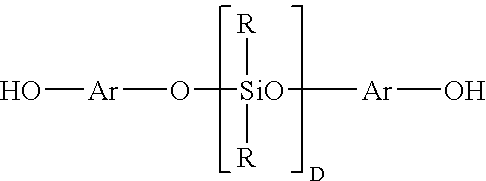White light-shielding compositions and articles comprising same
a technology of compositions and compositions, applied in the field of white lightshielding polymer compositions, can solve the problems of affecting the stability of polymers during processing, the inability to achieve high opacity, and the progressively more difficult to achieve light-shielding, and achieve good mechanical properties
- Summary
- Abstract
- Description
- Claims
- Application Information
AI Technical Summary
Benefits of technology
Problems solved by technology
Method used
Image
Examples
example 1
[0088]Four different compositions T1-T4 were formulated and tested for impact strength and heat stability. The polycarbonate-polysiloxane copolymer (PC-Si copolymer) had 20% siloxane by weight. The polycarbonate homopolymer PC-A was a high flow Bisphenol A polycarbonate with a target molecular weight of 21,900 (based on GPC using polycarbonate standards). The polycarbonate homopolymer PC-B was a low flow Bisphenol A polycarbonate with a target molecular weight of 29,900. PETS was used as a mold release agent. IRGAPHOS™ 168 (tris(2,4-di-t-butylphenyl)phosphate was used as a heat stabilizer. 2-(2′hydroxy-5-t-octylphenyl)-benzotriazole was used as an UV stabilizer. T1 was a blend of polycarbonate homopolymer and polycarbonate-polysiloxane copolymer. T2 added TiO2 to the blend of T1. T3 was a blend of two polycarbonate homopolymers. T4 added TiO2 to the blend of T3. T1 and T3 were formed into chips 1.0 mm thick; T2 and T4 were formed into chips 0.75 mm thick.
[0089]The sum of the polycar...
example 2
[0092]Six different compositions B1-B6 were formulated. Each composition included 45 parts PC-A, 37.5 parts PC-B, 17.5 parts PC-Si copolymer, 0.1 parts heat stabilizer, and 0.3 parts UV stabilizer. Each composition had a varying amount of TiO2 and various colorants. Each composition was formed into chips of 0.75 millimeter thickness and tested forwhiteness on the CIELAB color space, % T, Izod at 23° C., and ductility. The results were averaged and are shown in Table 2. Note that PC-A and PC-B are referred to together as “Polycarbonate” in this and further Tables.
TABLE 2UnitB1B2B3B4B5B6Polycarbonateparts82.582.582.582.582.582.5PC—Siparts17.517.517.517.517.517.5CopolymerHeatphr0.10.10.10.10.10.1StabilizerUV Stabilizerphr0.30.30.30.30.30.3TiO2parts6126449Pigmentparts000.00870.00580.00580.0131Brown 24Solvent Violetparts000.00460.00310.00310.006913Carbon Blackparts000.000160.000110.000320.00024L* @0.75 mmna96.697.490.490.490.090.3a* @0.75 mmna−0.4−0.41.41.31.21.3b* @0.75 mmna1.71.7−16.0−...
example 3
[0094]Several control compositions were made. Compositions C1-C7 used a blend of polycarbonate homopolymer and PC-Si copolymer, varying the amount of carbon black. The sample thicknesses were 0.75 mm. The results are shown in Table 3.
TABLE 3UnitC1C2C3C4C5C6C7Polycarbonateparts82.582.582.582.582.582.582.5PC—Siparts17.517.517.517.517.517.517.5CopolymerHeatphr0.10.10.10.10.10.10.1StabilizerUV Absorberphr0.30.30.30.30.30.30.3Carbon Blackphr00.00010.00030.00050.0010.0050.01L* @0.75 mm93.291.69087.883.660.143.2% T @0.75 mm%80.778.878.676.57246.827.2MVRcc / 10 min1010.6109.91010.110.1Izod @ 23° C.J / m902906901902902902884Ductility @%10010010010010010010023° C.Izod @ −30° C.J / m799793797816814800795Ductility @ −30° C.%100100100100100100100
[0095]Compositions C8-C14 used only polycarbonate homopolymer, varying the amount of carbon black. The sample thicknesses were 0.75 mm. The results are shown in Table 4.
TABLE 4UnitC8C9C10C11C12C13C14Polycarbonateparts100100100100100100100PC—Siparts0000000Copol...
PUM
| Property | Measurement | Unit |
|---|---|---|
| Temperature | aaaaa | aaaaa |
| Fraction | aaaaa | aaaaa |
| Fraction | aaaaa | aaaaa |
Abstract
Description
Claims
Application Information
 Login to View More
Login to View More - R&D
- Intellectual Property
- Life Sciences
- Materials
- Tech Scout
- Unparalleled Data Quality
- Higher Quality Content
- 60% Fewer Hallucinations
Browse by: Latest US Patents, China's latest patents, Technical Efficacy Thesaurus, Application Domain, Technology Topic, Popular Technical Reports.
© 2025 PatSnap. All rights reserved.Legal|Privacy policy|Modern Slavery Act Transparency Statement|Sitemap|About US| Contact US: help@patsnap.com



